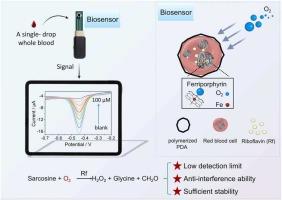Biomimetic self-oxygen-carrying electrochemical biosensor for highly sensitive detection of sarcosine in a single drop of whole blood
IF 3.7
1区 化学
Q1 CHEMISTRY, ANALYTICAL
引用次数: 0
Abstract
Riboflavin (Rf)-based sarcosine-oxidase mimicry is promising for point-of-care testing (POCT) for sarcosine (Sar) in ultra-micro whole blood. However, its sensitivity is limited by oxygen deficiency and blood interferents. Herein, we engineered a polydopamine (PDA)-coated red blood cell (RBC)-based Rf biosensor (PDA@Rf@RBC) with self-carrying oxygen via haemoglobin, boosting Rf catalysis of Sar while the RBC membrane excludes interferents and the PDA shell relays the electrical signal transmission. These integrated functionalities enable the biomimetic PDA@Rf@RBC biosensor to exhibit high sensitivity and robust anti-interference ability, allowing differential pulse voltammetry analysis with a low detection limit of 200 fM and a wide detection range of 10 pM to 100 μM for Sar. Under normal air conditions, the PDA@Rf@RBC biosensor demonstrates good reproducibility and stability for more than 30 days. Its precision is validated across serum, plasma, and whole blood, allowing POCT of trace abnormal Sar levels from a single drop (25 μL) of whole blood. This capability supports the auxiliary diagnosis of PCa and aids in assessing the risk of cardiovascular diseases. The proposed biomimetic electrochemical biosensor offers an efficient, rapid, and convenient approach for detecting blood Sar levels and establishes a novel design paradigm for oxygen-dependent sensors.

用于高灵敏度检测单滴全血中肌氨酸的仿生自携氧电化学生物传感器
基于核黄素(Rf)的肌氨酸氧化酶模拟技术有望用于超微量全血中肌氨酸(Sar)的即时检测(POCT)。然而,它的敏感性受到缺氧和血液干扰的限制。在此,我们设计了一种基于聚多巴胺(PDA)涂层的红细胞(RBC)射频生物传感器(PDA@Rf@RBC),通过血红蛋白自携氧,增强射频对Sar的催化作用,同时红细胞膜排除干扰,PDA外壳中继电信号传输。这些集成的功能使仿生PDA@Rf@RBC生物传感器具有高灵敏度和强大的抗干扰能力,可以进行差分脉冲伏安分析,检测限低至200 fM, Sar的检测范围宽至10 pM至100 μM。在正常空气条件下,PDA@Rf@RBC生物传感器具有良好的再现性和30天以上的稳定性。其精度在血清、血浆和全血中得到验证,允许单滴(25 μL)全血中痕量异常Sar水平的POCT。这种能力支持前列腺癌的辅助诊断,并有助于评估心血管疾病的风险。提出的仿生电化学生物传感器为检测血液Sar水平提供了一种高效、快速、方便的方法,并为氧依赖传感器建立了一种新的设计范式。
本文章由计算机程序翻译,如有差异,请以英文原文为准。
求助全文
约1分钟内获得全文
求助全文
来源期刊

Sensors and Actuators B: Chemical
工程技术-电化学
CiteScore
14.60
自引率
11.90%
发文量
1776
审稿时长
3.2 months
期刊介绍:
Sensors & Actuators, B: Chemical is an international journal focused on the research and development of chemical transducers. It covers chemical sensors and biosensors, chemical actuators, and analytical microsystems. The journal is interdisciplinary, aiming to publish original works showcasing substantial advancements beyond the current state of the art in these fields, with practical applicability to solving meaningful analytical problems. Review articles are accepted by invitation from an Editor of the journal.
 求助内容:
求助内容: 应助结果提醒方式:
应助结果提醒方式:


